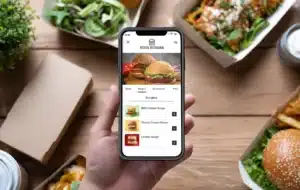Egypt’s restaurant sector is evolving rapidly, especially with rising competition, shifting consumer behaviors, and the emergence of new generations like Gen Z. Accordingly, keeping up with these changes has become essential for staying relevant and successful.
Digital transformation is no longer an option. It’s a necessity for any restaurant seeking growth and a quality customer experience. However, to achieve effective results, dependence on technology alone isn’t enough. Restaurants need to follow best practices and learn from successful market experiences to meet both operational and profitability goals.
Studies estimate the size of the food service market in Egypt at $10.35 billion in 2025. It’s also expected to double to $21.25 billion by 2030, representing a compound annual growth rate (CAGR) of 15.47% during the forecast period (2025-2030).
Moving to Cloud-based Cashier System
One of the best practices for digital transformation in Egypt is the adoption of a cloud-based cashier or point-of-sale (POS) system.
Here are the main reasons to use this system in restaurants and cafes.
Instant access to data
With a cloud-based cashier, you can track your sales, inventory movements, and branch performance from any device in real-time, without delay. This helps you make faster, more accurate decisions.
Seamless remote management
Whether you’re at home or on vacation in the North Coast, you can fully manage your business. A cloud POS enables you to add products, adjust prices, review reports, or even monitor staff performance, all via mobile phone or laptop.
Simplified multi-branch management
If you manage more than one branch, a cloud cashier acts as a restaurant management system. It makes managing branches easier for you, without having to visit each one or track their data separately.
Data security and regulatory compliance
Modern restaurant cashier systems use solid encryption technologies to secure your information. They comply with local and international regulations, providing peace of mind and security for you and your customers.
Switching to Digital Payment: A Smart Move for Modern Restaurants
Adopting digital payment solutions such as e-wallets, bank cards, and contactless options like Apple Pay (available in Egypt) has become essential for any restaurant keeping up with the times.
These solutions provide customers with a faster, easier payment experience. They also help reduce cash handling, a major part of Egypt’s Vision 2030 and its support for financial inclusion and transition to a cashless society.
Transactions in restaurants, cafes, and even food trucks have to be smooth and secure for customers, without the errors and issues of traditional and cash payments
Integrating Online Orders and Delivery Platforms
Using delivery platforms is one of the best ways for restaurants to expand and boost profitability. Incorporating technology into these platforms is a step toward digital transformation.
Here are a few ways to integrate with and increase online food orders.
Collaboration with major delivery apps
Partnerships with well-known delivery platforms like Talabat, elmenus, and Mrsool give your restaurant a chance to expand and access a larger customer base. These platforms help you reach younger generations who rely on delivery apps to order food every day.
It’s also a smart way to market your restaurant indirectly and boost sales without much effort.
Website or app creation
While third-party apps are important, having a restaurant website or mobile app is an important, direct sales channel. Entirely under your control.
This helps you reach customers without paying high commissions. It also allows you to build direct loyalty and increase interaction through personalized offers and discounts.
Connecting online orders to your cashier system
Automating orders on your cashier system helps minimize manual intervention, reducing human errors when executing orders.
It displays all incoming orders on a single screen, making it easier to track, analyze, and streamline operations. This makes the workflow smoother and more efficient.
Automating Inventory and Supply Chain Management
Automating inventory and supply chain management is a key factor for any restaurant’s success. It ensures operational efficiency, reduces waste, and helps prevent theft.
By tracking inventory in real-time, you can identify shortages and ingredients nearing expiration. This helps you cut losses and optimize the use of available resources.
Combining inventory monitoring with automated ordering from suppliers makes purchasing more seamless and consistent, with no manual intervention.
This smart integration enables restaurant owners to maintain ideal inventory levels that meet operational needs without excess or shortage. Ultimately, this contributes to cutting operating costs and raising profits.
Benefiting from Data Analytics
Tracking sales trends, peak hours, and customer preferences through data analytics, such as menu engineering, allows you to identify your best-selling dishes, the busiest times and days, and what your guests prefer. This information helps you develop and design your menu, adjust shifts, and plan promotional offers.
Using predictive analytics to improve inventory and HR management by analyzing previous data and relying on forecast technologies enables you to predict future demand for products and services.
This contributes to adjusting stock levels and determining the number of employees needed to cover peak hours. As a result, this reduces waste and enhances operational efficiency.
Monitoring financial performance in real-time helps you see revenues and expenses as they happen. It helps you make quick decisions to deal with any sudden financial changes. It also enables you to improve your menu pricing strategy and reduce unnecessary expenses.
Enhancing Customer Experience with Technology
Loyalty programs and CRM systems
Implementing a customer-centric loyalty program and a customer relationship management (CRM) system helps build a strong relationship with customers. Restaurant loyalty programs reward customers when their purchases and visit frequency increase, and invite others.
Meanwhile, CRM systems help you collect data like names and mobile phone numbers, along with details like preferences and purchasing behaviors.
This not only helps you deliver customized offers and services, but also solidifies the restaurant-customer relationship and boosts loyalty and brand attachment.
Using QR codes for menus and orders
Incorporating QR codes into your menu and ordering options simplifies the customer experience at your restaurant. With just a tap, a customer can browse the menu, reducing crowding and speeding up the ordering process.
This technology offers customers a modern experience while minimizing manual errors in order-taking. It also provides more flexibility in updating the menu.
Customizing marketing campaigns
By analyzing customer data stored in your CRM system and digital programs like loyalty programs, you can design marketing campaigns tailored to meet your customers’ needs and preferences.
This strategy helps you target various customer segments with the proper offers and discounts. This increases the chances of a successful marketing campaign and a deep connection with customers, bolstering relationships and brand trust.
Restaurant Staff and Technology
To improve your restaurant’s chances of digital transformation success, you have to start from the inside. How? By training your staff on new digital tools such as cashier systems, tablets, self-ordering screens, and others.
As a restaurant owner or manager, you can also track data and analytics to better support your staff.
You should also encourage your staff to constantly learn and try their new ideas, as innovation drives development. When your restaurant’s culture is technology-based and change-driven, your team becomes the primary engine of success.
Compliance with Egyptian Regulations
To ensure compliance with Egyptian regulations, it’s necessary to adopt integrated technology solutions that meet modern e-invoicing requirements. This includes choosing systems capable of issuing e-invoices accurately and automatically, simplifying tax reporting, and minimizing administrative errors.
You can use restaurant accounting and financial management programs that streamline invoicing, tax calculations, and more.
You can use Foodics’ accounting system, which integrates with your restaurant management system and the other technology tools mentioned above.
To Conclude
Digital transformation is no longer an option; it’s a strategic necessity for any restaurant seeking growth in a fast-changing market like Egypt.
Adopting technology in operations management, data analysis, and customer engagement grants restaurants a true competitive edge. It helps them deliver a seamless, professional experience that meets modern customers’ expectations.
Restaurants that keep up with this shift not only maintain their operational efficiency, but also become better equipped to expand, adapt to changing consumer behavior, and face economic challenges. Therefore, investing in digital transformation is an investment in your restaurant’s future, growth potential, and position within a smarter, more innovative hospitality scene.
Are you ready to start your restaurant’s digital journey? Discover how Foodics can back your restaurant at every step of its digital transformation in the Egyptian market.



